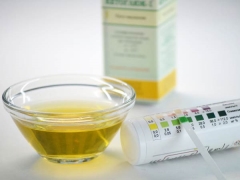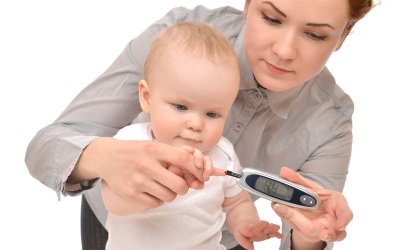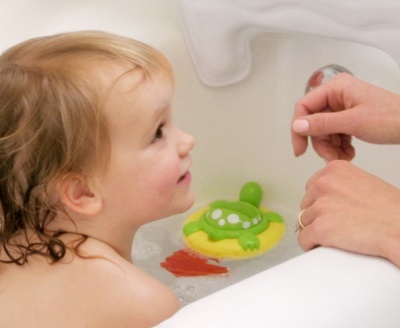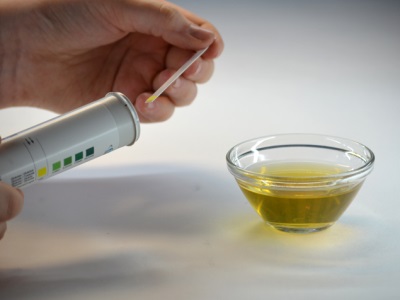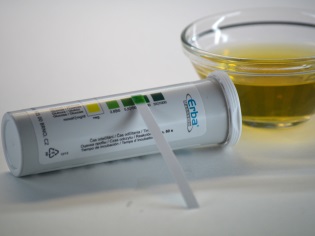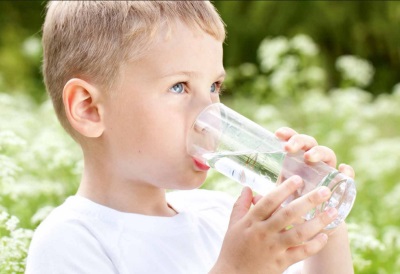Glucose in the urine of a child
Changes in urine tests help identify different diseases in the child and begin their timely treatment. What does the appearance in the urine glucose analysis show?
What does mean?
Glucose is a simple carbohydrate, which is the main source of energy for the human body. All carbohydrates that come with food in the child's digestive tract are broken down with the help of enzymes to glucose. In this form, carbohydrates are used by the cells of the body.
The concentration of glucose in a child’s blood is at the same level. Appearance in urine becomes possible when a certain threshold is exceeded. blood glucose (for most children, this threshold is 10 mmol / l) or in violation of the processes of glucose reuptake in the kidneys. This condition is called glucosuria.
Symptoms
If there is an increase in glucose in the urine, the child may experience signs such as:
- Frequent urination
- Increase thirst
- Weight loss
- Fatigue, sleepiness and weakness
- Itchy and dry skin
The reasons
The main reason that can cause the appearance of glucose in children's urine is diabetes. In more rare cases, the following problems lead to glycosuria:
- Pheochromocytoma;
- Acromegaly;
- Cushing's syndrome;
- Hyperthyroidism;
- Cystinosis;
- Malabsorption syndrome;
- Intestinal infection;
- Renal impairment, at which the glucose clearance threshold is lowered;
- Fever;
- Acute pancreatitis;
- Traumatic brain injury, encephalitis, meningitis;
- Glomerulonephritis;
- Burns
Disease progression
Often, the detection of glucose in the urine is associated with its excessive content in the blood, which affects renal filtration. Glucose is not completely absorbed by the kidneys back, so it begins to be excreted in the urine. This leads to a gradual decrease in the blood glucose level and starvation of the cells that were supposed to receive this glucose as energy.
Forms
Distinguish between the hereditary form of glucosuria (primary), which is caused by genetically determined disorders of glucose metabolism, as well as secondary, associated with kidney diseases, for example, with poisoning.
Separately, emotional glucosuria, caused by stress, and alimentary, are distinguished when glucose appears after changes in nutrition (consumption of an excess of simple carbohydrates).
Kinds
The division of glycosuria into different species is based on the cause of the onset of such a symptom. There are the following types:
- Renal. It is caused by renal congenital pathologies, due to which glucose enters the urine in an increased amount. The disease is manifested by a feeling of hunger, fatigue, weakness. A dietary regimen is recommended for treatment in order to maintain blood glucose levels.
- Renal. With this type of disease, the level of glucose in the urine is increased, and in the blood it is normal. This is due to impaired glucose absorption in the kidneys, for example, in case of nephrosis or renal failure.
- Daily. Glucose is detected in the urine during the day, usually after considerable physical exertion and excessive consumption of sweet foods.
What analysis is determined?
The determination of glucose in the urine is carried out during general urine analysis. If such a study reveals glucose, the child is prescribed a retake analysis, as well as a blood test. There is also a rapid diagnosis of the presence of glycosuria, in which use special test strips. In addition, determine the glucose in the daily urine.
Training
In order for a urine test to be reliable, it is important to follow all recommendations for collecting a sample for it. The child must be held toilet genitals, in the urine does not hit the substance, because of which glucose will quickly decompose. Urine is collected in a sterile container, tightly closed and transported to the laboratory within one to two hours.
Sometimes the child has to take daily urine, then the first portion, selected in the morning, is not taken, and starting from the second urination, all the urine is collected in a separate container, the first urination of the next day is also included. Capacity for collecting at the same time is stored in the refrigerator.
Then it is necessary to measure the entire volume of urine, select 100 milliliters for analysis, indicate on the form attached to this sample the child’s data and the total volume of urine per day, after which deliver the portion of urine to the laboratory.
Test strips for diagnostics
In some cases, glucose in the urine is detected by special indicator strips. The basis of this analysis is the interaction of glucose with the enzyme glucose oxidase with the release of hydrogen peroxide, splitting it with peroxidase and oxidation of the dye on the strip. The reaction occurs only in the presence of glucose in the sample of urine. This is a qualitative method that helps answer the question of whether there is glucose in the urine. It does not determine the exact concentration; by changing the color, it can only be determined approximately.
In the diagnosis used strips, the width of which is 5 mm, and the length - 5 cm. They have a strip of light yellow color, impregnated with dye and enzymes. Coloring of this particular area occurs during the reaction to glucose.
In order to conduct the test correctly, the indicator strip should be lowered into the urine so that the reagents get wet, after which it is immediately removed and allowed to lie down for two minutes. It remains to compare the band where the reagents were located, with the control scale. Remember that the strips should be properly stored and not touch the indicator areas with your fingers.
Norm
Glucose enters the urine in such a small amount that it is not detected by tests, so the complete absence of glucose in a child's urine sample will be the norm.
When can the result be false positive?
If a child on the eve ate a lot of sweet, including fruit, the result may be elevated. Also, misuse of glucose in the urine can be caused by taking various medications, for example, preparations containing tannin, salicylic acid, senna, saccharin, caffeine.
With a positive analysis, the doctor should suspect diabetes and refer the child to blood tests that will help confirm fears or refute them.
The result may be false negative. If the child has used ascorbic acid in large quantities, the excretion of glucose in the urine will not.
Diet
The dietary habits of a child who has been diagnosed with glycosuria should correspond to a disease, a symptom of which is the release of glucose in the urine. If the violation is caused by excessive consumption of carbohydrate foods, then a child is recommended a diet in which simple carbohydrates are limited.
When glycosuria is also often marked dehydration and potassium deficiency, it is therefore important to monitor the sufficient amount of drinking for the child and the use of vegetables, cereals, legumes.
Folk remedies
Before using any funds from the national first-aid kit should consult a doctor. The child can be given such funds:
- A decoction of nettle leaves and blueberries, as well as dandelion roots. A spoonful of chopped ingredients pour a glass of boiled water. The tool is taken in half a glass three times a day before meals once every 8 days.
- Tincture oatmeal. Pour a glass of oatmeal 5 cups of water, which boil, boil for one hour. After straining the tincture can be consumed by the child in unlimited quantities.
- Add to each dish cinnamon in the amount of 1/2 teaspoon per day.
- A decoction of berries and leaves of blueberries. Finely chopped raw materials in the amount of 1 spoon pour 2 cups of water and boil for 5 minutes. Broth should be taken 15 minutes before meals for 1/2 cup.
